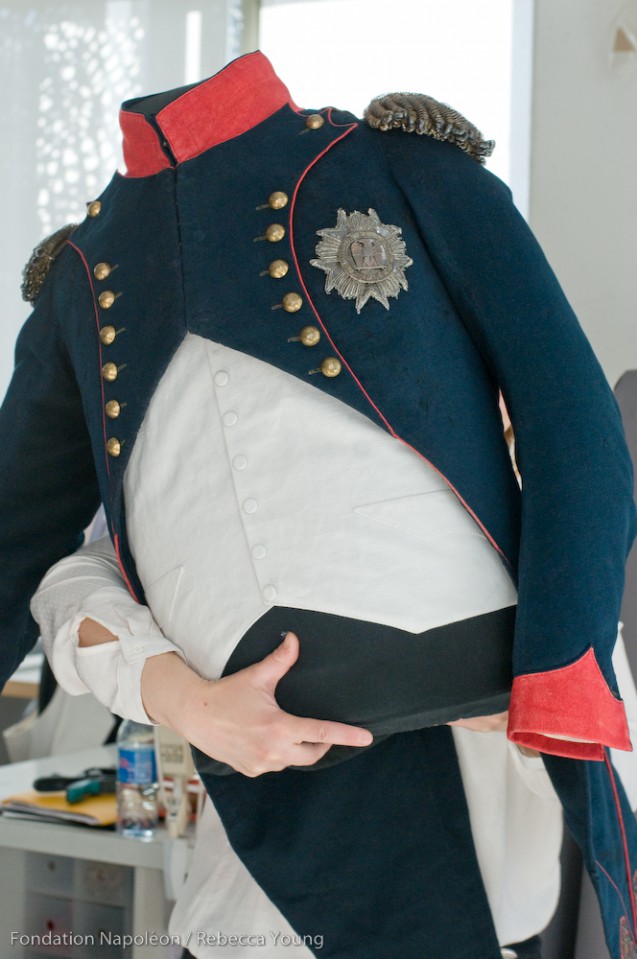Does the fact that this object has such a strong historical and emotional significance affect your approach to its restoration?
Raphaëlle Déjean: Our deontology requires us not to differentiate according to the type of work we are dealing with. Whether it be a personal object of sentimental value or a significant work from museum collection, we apply the same rigour and the same care and attention. But given that an object of historical or symbolical importance is often subject to greater attention on the part of those who are responsible for it, the working conditions can therefore be a little different: Given the increased interest in the overall operation, including the details and finishings, there are more visits and questions as well as mediatisation surrounding the work. Therefore, as well as fulfilling the technical part of our work, we also have to play a pedagogical role and participate in the communication which is stimulating but demanding.
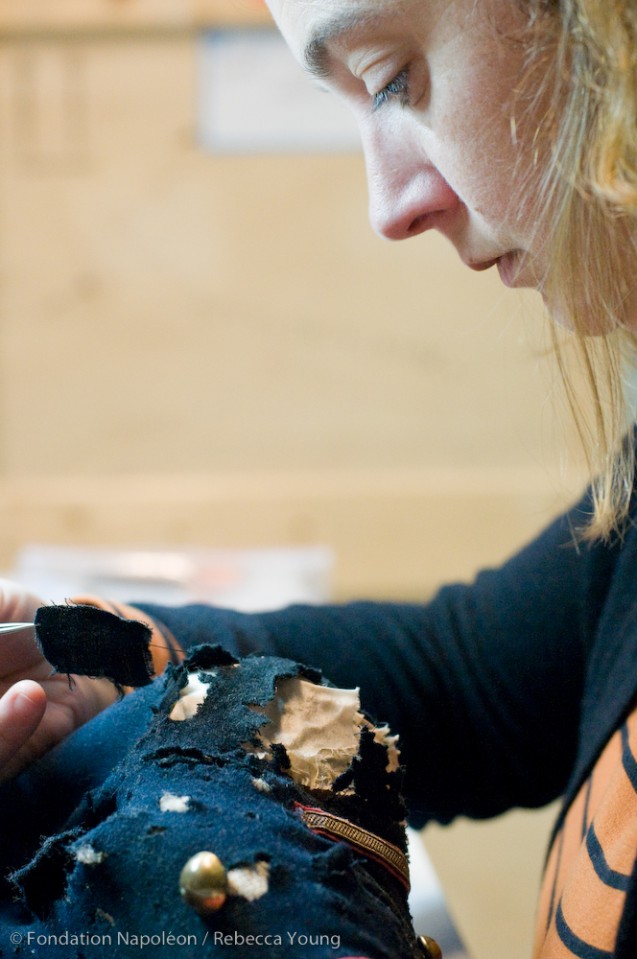
Did the presence of a previous restoration on this uniform pose any problems?
Raphaëlle Déjean: The previous restoration was well done, but it was not complete: some parts (the shoulders, the interior) had not been consolidated, so there were still some parts missing. The restoration also showed signs of age: the fabrics and threads used were discoloured and had become very visible. Since that restoration took place (about 20 years ago) conservation techniques have evolved. So we decided to withdraw these older interventions almost completely, only a few consolidations on the lining have been preserved.
How far do you go when restoring a textile?
Raphaëlle Déjean: Our goal is twofold. Firstly, we try to preserve as much as possible everything that is original, whether it be the textile material (here the wool broadcloth or the twill lining) or indeed the sewing techniques (the actual stitching and threads). All these elements must be consolidated in order to avoid further deterioration. But the aim is also to restore as much as possible the appearance of the object, so the restoration has to be done discreetly and enhance the object without there being any confusion between the original and the restored parts, for the sake of authenticity.
This garment was originally green but now it appears blue: can you explain the change in colour, and why not restore it to its original colour?
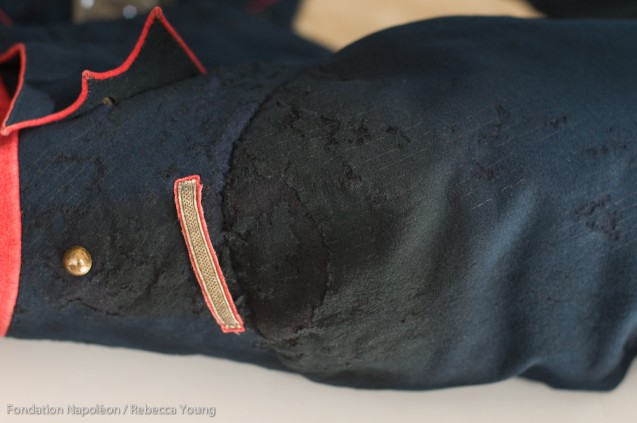
Raphaëlle Déjean: The uniform was green because the wool broadcloth had been dyed with both blue and yellow [natural] dyes. Since yellow dyes are more fragile, they were the first to disappear when the uniform was exposed to light. Now only the blue components of the original colour remain [with the exception of parts of the garment that have been protected from the light]. We cannot restore the original green shade to the coat. The only way to do this would be actually to dye the blue parts again, which is not acceptable from an ethical point of view: the object would be altered forever. We always try to make sure that our interventions are reversible. In that way, if – and when – new conservation techniques are developed in the future, we allow the possibility to do an even better job sometime in the future.
Can you tell us more about your collaboration with the costume designer, Gaëtan Leudière? How did you decide about the presentation of this historical object (with regard to the material constraints, desire for realism …) in a way that is both authentic and theatrical?
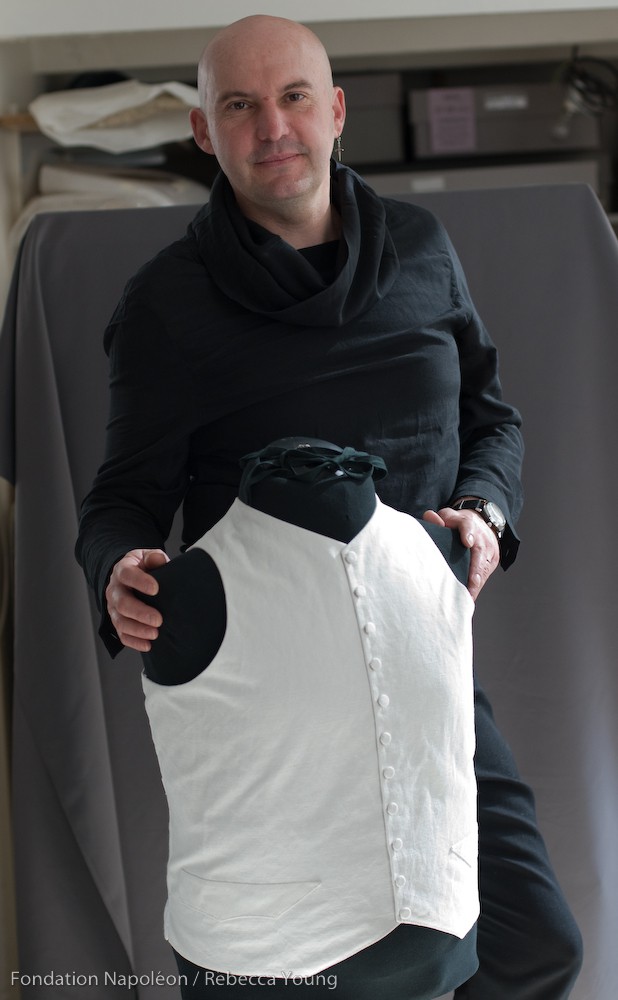
Raphaëlle Déjean: The uniform was previously presented on a mannequin with a rather approximate staging – with a waistcoat made of chamois leather, and an anachronistic red sash.
Firstly, the mannequin had to be remodelled because it was too large and as a result it pulled on the seams of the uniform. Since its measurements were not those of Napoleon, it was not doing its job. It had to be slimmed down, and the padding has therefore been distributed differently to better imitate the physiognomy and posture of the Emperor. It is also now more suitable for the preservation of the coat since it provides better support and makes it look better.
Secondly, it was decided to display the uniform together with a copy of a waistcoat that the Emperor actually wore on St Helena. In preparation for this copy, Gaëtan Leudière initially carried out an analysis of this waistcoat [now in the collection of the Fondation Napoléon] and then made a prototype. A fitting on the mannequin allowed us to confirm the measurements.
Then we discussed together the choice of fabric: this step was essential in order to create a waistcoat that would look plausible. We wanted to achieve an effect as close as possible to that of the original pique cotton of Napoleon’s waistcoat.
Lastly there was a certain amount of work on all the details which give a historical appearance: hand-stitches on the bottom of the waistcoat and around the pockets, bias-cutting of the fabric of the pockets, and buttons covered in the same fabric as the waistcoat.
Our collaboration was very interesting and constructive: we have been able to propose a reconstitution that harmonised perfectly with the uniform, yet at the same time not leaving any room for doubt about the authenticity of the waistcoat since several aspects clearly show that it is an element of scenography.
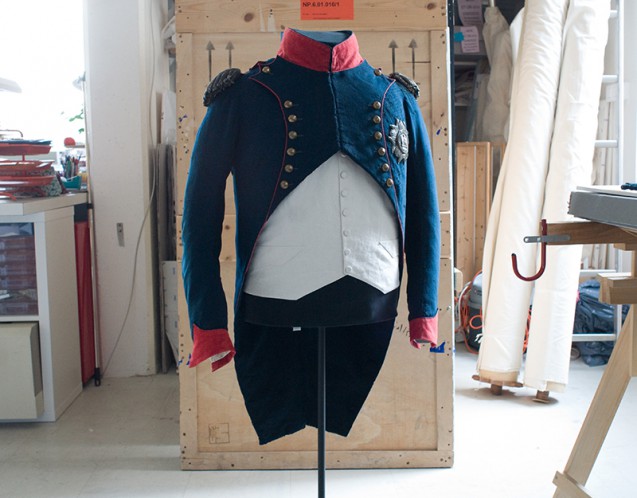
Interview compiled and translated by Rebecca Young (March 2017)
Have a look at some more photographs of the uniform: Before, during and after the conservation work.
Raphaëlle Déjean is a textile restorer/conservation expert. After studying chemistry and art history, in 2008 she obtained a Masters in Conservation-Restoration of Cultural Property, from the University of Paris 1. Since then she has worked freelance at various heritage institutions or at the multidisciplinary workshop she shares with several colleagues in Paris. Her experiences for a wide range of collections (Louvre Museum, Cluny Museum, Quai Branly Museum, Galliera Museum, Decorative Arts, Chateau de Versailles …) has given her an understanding of a wide variety of textile objects based on differing technologies and needs.
Gaëtan Leudière, a graduate of the École Nationale Supérieure des arts et techniques du théâtre, creates dresses, corsets, dance costumes and historical clothing for the cinema (he worked on the costumes of the films Bossu, Ridicule, Sade or La Rue des plaisirs and Asterix) for the theatre (théâtre National de Chaillot) and also for dance. Now director of his own company “Feteach”, he continues his creative work as well as teaching at the INJS (French National Institute for Young Deaf in Paris) and at the Chambre Syndicale de la Haute Couture Parisienne.


